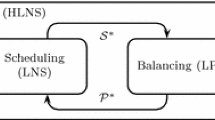Abstract
The multi-trip time-dependent vehicle routing problem with soft time windows and overtime constraints (MT-TDVRPSTW-OT) is considered in this paper. The modified hierarchical multi-objective formulation and the equivalent single-objective formulation are proposed. The iterative multi-trip tour construction and improvement (IMTTCI) procedure and the single-trip tour counterpart procedure with post-processing greedy heuristic (ISTTCI-GH) are proposed to solve the problem. These procedures are based on the ruin and recreate principle, and consider trade-offs among cost components (vehicle usage, number of early/late soft time window occurrences, transport distance, transport time, overtime and early/late soft time window penalty costs) in the search process. From the computational experiment, the IMTTCI procedure outperforms the existing efficient insertion heuristic with 42.09% improvement in number of vehicles and 24.30% improvement in travel time for the constant-speed multi-trip vehicle routing problem with hard time windows and shift time limits, a special case of MT-TDVRPSTW-OT problem, on all problem instances. For the MT-TDVRPSTW-OT problem, the ISTTCI-GH and the IMTTCI outperform the ISTTCI on all problem groups by 43.21% and 69.44% in the number of vehicles (the primary objective), respectively. The IMTTCI outperforms the ISTTCI-GH in number of vehicles by 51.07%, but takes 42.83% longer CPU time than the ISTTCI-GH. The performance of IMTTCI in terms of the primary objective improves with the increase of mean speed as well as the increase of time window width and planning horizon across all customer configuration types, tighter/looser time windows, shorter/longer planning horizon and various time-dependent travel speed profiles. The sensitivity analysis of different problem parameters is performed. The complexity analysis of the proposed procedures shows that the proposed procedures are solvable in polynomial time, and from the computational results the relationships between the CPU time and problem size confirm this. For the MT-VRPSTW-OT, a mixed integer program and the special case of MT-TDVRPSTW-OT, on 12-customer instances, the proposed IMTTCI algorithm yields the average optimality gap of 1.35% with the average CPU time of 0.66 seconds, whereas the GAMS/CPLEX solver yields the average optimality gap of 0.83% with the average CPU time of 256.39 seconds. The proposed IMTTCI algorithm yields only 0.52% greater optimality gap but 388 times faster CPU time than the commercial solver.

Similar content being viewed by others
References
Ahn BH, Shin JY (1991) Vehicle-routing with time windows and time-varying congestion. J Oper Res Soc 42(5):393–400
Barr RS, Golden BL, Kelly JP, Resende MGC, Stewart WR (1995) Designing and reporting on computational experiments with heuristic methods. J Heuristics 1(1):9–32
Braekers K, Ramaekers K, Nieuwenhuyse IV (2016) The vehicle routing problem: State of the art classification and review. Comput Ind Eng 99:300–313
Brandao J, Mercer A (1997) A Tabu search algorithm for the multi-trip vehicle routing problem. Eur J Oper Res 100:180–191
Cattaruzza DC, Absi N, Feillet D (2016) Vehicle routing problems with multiple trips. 4OR: A Quarterly Journal of Oper Res 14:223–259
Desrochers M, Lenstra JK, Savelsbergh MWP, Soumis F (1988) Vehicle routing with time windows: optimization and approximation. Vehicle Routing: Methods and Studies 16:65–84
Figliozzi MA (2010) An iterative route construction and improvement algorithm for the vehicle routing problem with soft time windows. Transp Res C 18:668–679
Figliozzi MA (2012) The time dependent vehicle routing problem with time windows: Benchmark problems, an efficient solution algorithms, and solution characteristics. Transp Res E 48:616–636
Fleischmann B (1990) The vehicle routing problem with multiple use of vehicles. Fachbereich Wirtschaftswissenschaften, Universitat Hamburg, Technical report
Francois V, Arda Y, Crama Y, Laporte G (2016) Large neighborhood search for multi-trip vehicle routing. Eur J Oper Res 255:422–441
Golden B, Wasil E, Kelly J, Chao I (1998) Metaheuristics in vehicle routing. In: Craignic T, Laporte G (eds) Fleet Management and Logistics. Kluwer, Boston
Hill AV, Benton WC (1992) Modeling intra-city time-dependent travel speeds for vehicle scheduling problems. J Oper Res Soc 43(4):343–351
Ichoua S, Gendreau M, Potvin JY (2003) Vehicle dispatching with time-dependent travel times. Eur J Oper Res 144(2):379–396
Karoonsoontawong A (2015) Efficient insertion heuristics for multi-trip vehicle routing Problem with time windows and shift time limits. Transportation Research Record: Journal of the Transportation Research Board 2477:27–39
Karoonsoontawong A, Kobkiattawin O, Xie C (2017) Efficient insertion heuristic algorithms for multi-trip inventorey routing problem with time windows, shift time limits and variable delivery time. Networks and Spatial Economics. https://doi.org/10.1007/s11067-017-9369-7 Online First
Lahyani R, Khemakhem M, Semet F (2015) Rich vehicle routing problems: From a taxonomy to a definition. Eur J Oper Res 241:1–14
Malandraki C, Daskin MS (1992) Time-dependent vehicle-routing problems: formulations, properties and heuristic algorithms. Transp Sci 26(3):185–200
Malandraki C, Dial RB (1996) A restricted dynamic programming heuristic algorithm for the time dependent traveling salesman problem. Eur J Oper Res 90(1):45–55
Miller CE, Tucker AW, Zemlin RA (1960) Integer Programming Formulation of Traveling Salesman Problems. Journal of the ACM 7(4):326–329
Moon I, Lee J-H, Seong J (2012) Vehicle routing problem with time windows considering overtime and outsourcing vehicles. Expert Syst Appl 39:13202–13213
Olivera A, Viera O (2007) Adaptive memory programming for the vehicle routing problem with multiple trips. Comput Oper Res 34:28–47
Ouaddi K, Benadada Y, Mhada F-Z (2018) Ant Colony System for Dynamic Vehicle Routing Problem with Overtime. Int J Adv Comput Sci Appl 9(6):306–315
Petch R, Salhi S (2004) A multi-phase constructive heuristic for the vehicle routing problem with multiple trips. Discret Appl Math 133:69–92
Ren Y, Dessouky M, Ordonez F (2010) The multi-shift vehicle routing problem with overtime. Comput Oper Res 37:1987–1998
Salhi S, Petch RJ (2007) A GA based heuristic for the vehicle routing problem with multiple trips. Journal of Mathematical Modelling and Algorithms 6:591–613
Schrimpf G, Schneider J, Stamm-Wilbrandt H, Dueck G (2000) Record breaking optimization results using the ruin and recreate principle. J Comput Phys 159(2):139–171
Solomon MM (1987) Algorithm for the Vehicle Routing and Scheduling Problem with Time Window Constraints. Oper Res 35:254–265
Taillard E, Badeau P, Gendreau M, Guertin F, Potvin JY (1997) A tabu search heuristic for the vehicle routing problem with soft time windows. Transp Sci 31(2):170–186
Taillard E, Laporte G, Gendreau M (1996) Vehicle routing with multiple use of vehicles. J Oper Res Soc 47:1065–1070
Acknowledgments
The first author gratefully acknowledges the support from King Mongkut’s University of Technology Thonburi and The Thailand Research Fund under contract number RSA5980030 and the Institutional Research Capability Development Grant. The second author is supported by The Petchra Prajom Klao Ph.D. Research Scholarship, King Mongkut’s University of Technology Thonburi.
Author information
Authors and Affiliations
Corresponding author
Additional information
Publisher’s Note
Springer Nature remains neutral with regard to jurisdictional claims in published maps and institutional affiliations.
Appendix
Appendix
Time-Dependent Travel Time Calculation Example
Consider an arc (i, j) with the length of one unit. The travel speed step function is given below and shown in Figure 2:
Table 14 shows the detailed calculation from the adopted procedure tij(bi) based on Ichoua et al. (2003) and that from Malandraki and Daskin (1992) on a travel speed step function example. From Figure 3, in the bi range of [0.5, 1], there is the slope of (0.1-2)/(1-0.5)= -3.8 (i.e., less than -1) for the travel time function based on Malandraki and Daskin (1992), and the slope of (0.1-0.575)/(1-0.5)= -0.95 (i.e., grater than -1) for the travel time function based on Ichoua et al. (2003). Thus, in Figure 4, the arrival time function based on Ichoua et al. (2003) is strictly increasing and yields the non-passing property, whereas that based on Malandraki and Daskin (1992) is not strictly increasing and does not satisfy the non-passing or FIFO property.
Rights and permissions
About this article
Cite this article
Karoonsoontawong, A., Punyim, P., Nueangnitnaraporn, W. et al. Multi-Trip Time-Dependent Vehicle Routing Problem with Soft Time Windows and Overtime Constraints. Netw Spat Econ 20, 549–598 (2020). https://doi.org/10.1007/s11067-019-09492-3
Published:
Issue Date:
DOI: https://doi.org/10.1007/s11067-019-09492-3







